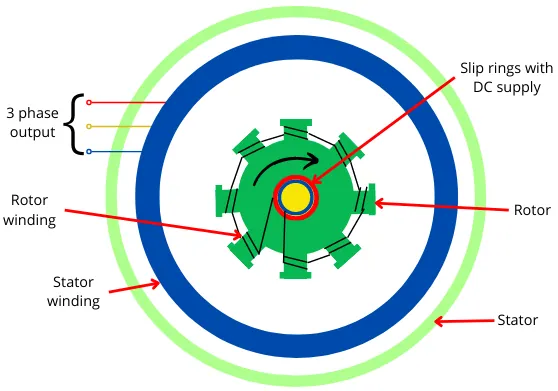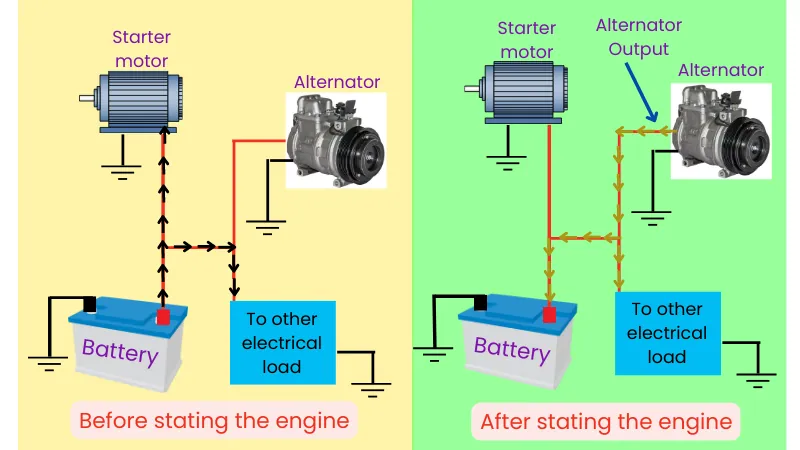The key difference between the Alternator and Battery is that the alternator converts the mechanical energy into electrical energy while the battery converts the chemical energy into electrical energy.

In this article, we’re going to discuss:
- Alternator:
- Battery:
- Difference between Alternator and Battery:
- FAQs:
Alternator:

Alternator is an electrical power generator that converts the mechanical energy of a prime mover into electrical energy.
It is generally used in automobiles to develop electrical power to run the accessories in the vehicle and to charge the battery.
It generally consists of the following components: Rotor, stator, slip ring, rectifier, and regulator.
The rotor is an electromagnet that is excited by the DC current receiving through slip rings. The pulley mounted on the rotor shaft gets power from the crankshaft.
As the rotor starts rotating, it forms a rotational magnetic field. It generates electromotive (emf) force into the stator winding which causes current to flow into the stator winding.
The alternator is used in various applications, especially in automotive applications to generate electrical power from the mechanical energy of the crankshaft.
Battery:
Battery is a device that converts chemical energy into electrical energy by an electrochemical reaction. It generally consists of one or more electrochemical cells.
The batteries generally consist of the following basic components: Cathode, anode, electrolyte, etc.
Electric batteries are used in a huge range of applications that require electrical energy.
In automotive, the main purpose of the battery is to run the starter motor to start the IC engine and to run the different electrical accessories like power steering, Power windows, air conditioner, wipers, etc.
The left side circuit in below figure shows that before starting the engine, the battery supplies power to the starter motor and to other electrical loads while the right side circuit shows that when the engine is in the running situation, the alternator supplies power to the all electrical load in the vehicle and also provides power to charge the battery.

Read here: Is it possible to drive a car without Battery?
Difference between Alternator and Battery:
| Sr. No. | Alternator | Battery |
|---|---|---|
| 1 | It is a device that converts mechanical energy into electrical energy. | The battery stores the electrical energy and supplies electrical energy to the different equipments. |
| 2 | The alternator provides the electrical energy to the equipments after the prime mover (engine) gets started. | In automobiles, the battery helps to run the electrical equipment before the engine gets started. |
| 3 | The alternator gets the power from the crankshaft of the engine. | The alternator provides power to charge the battery. |
| 4 | The alternator is an AC device. | A battery is a DC device. |
| 5 | The bad alternator can cause charging issues for the battery. | A bad battery can cause starting issues in a vehicle. |
| 6 | The alternator is specified by its current and voltage. | The battery is specified by its voltage and capacity (Ah). |
| 7 | The alternator has moving components. | The battery doesn’t have any moving components. |
| 8 | The alternator commonly consists of a stator, rotor, armature, pulley, etc. | The common components of the battery are cathode, anode, electrolyte solution, etc. |
FAQs:
-
Where do an alternator and a battery work together?
Battery and alternator are mostly used together in automobiles to provide the electric power to the different electric accessories.
-
When does the battery and alternator supply power to the car’s electric accessories?
The battery supplies the power while starting the engine. Once the engine gets started, the alternator starts supplying power to all accessories and also recharges the battery.